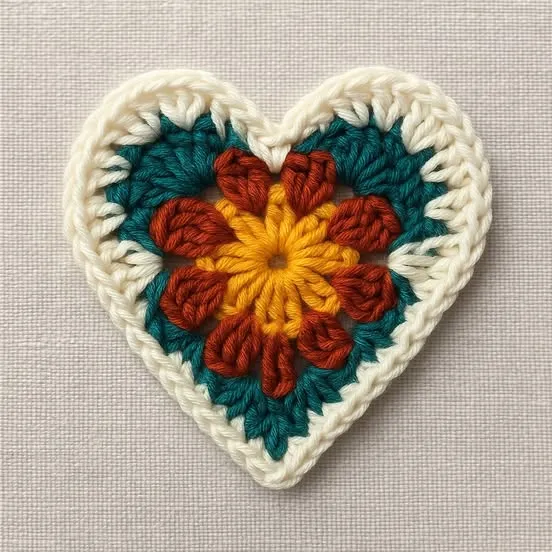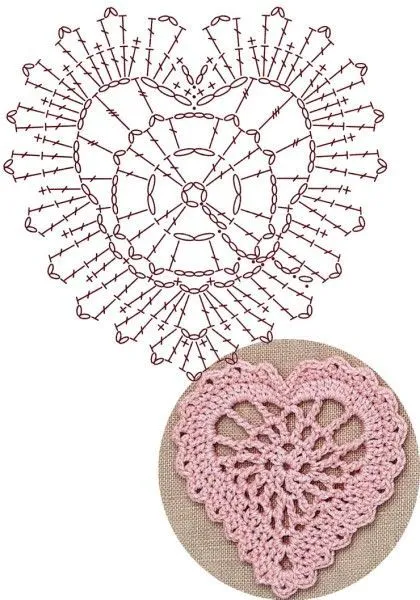
Crochet Hearts Diagrams – The Ultimate Guide is the perfect starting point for anyone who wants to combine creativity with the comforting art of crochet.
Whether you’re crafting gifts, home décor, or embellishments for your clothing, learning how to read crochet heart diagrams can completely transform your projects.
These tiny yet meaningful creations are more than just cute patterns—they’re symbols of love, care, and dedication woven into every stitch.

Understanding how to follow crochet heart diagrams is an empowering skill for both beginners and advanced crocheters.
Diagrams eliminate language barriers and allow you to interpret any pattern visually, no matter where it comes from. The beauty of a diagram lies in its universal symbols—once you grasp them, you can create any type of heart design: flat, 3D, lace-style, or stuffed. This guide will help you master these symbols, decode their meanings, and apply them to real projects.
In this comprehensive tutorial, you’ll discover how to read, follow, and adapt crochet heart diagrams to your own creative style. We’ll explore different stitch types, yarn choices, and finishing touches to make your hearts stand out. By the end of this article, you’ll feel confident enough to design your own patterns and make personalized crochet hearts for every occasion—birthdays, Valentine’s Day, weddings, or just because.
To begin, let’s understand what crochet heart diagrams actually are. A crochet diagram is a visual representation of a pattern, using symbols instead of words. Each symbol corresponds to a specific crochet stitch, like chain, single crochet, double crochet, or slip stitch. When arranged together, these symbols create the complete design of a heart. The diagram shows the direction of your work, the order of stitches, and how rounds or rows connect.
Reading crochet heart diagrams may seem intimidating at first, but it becomes easier with practice. The key is to identify the starting point—often a small circle that represents a magic ring or chain loop—and follow the pattern outward. Arrows or numbers on the diagram will show you where to begin and in which direction to work. Once you understand how these visual guides function, you’ll never need to rely solely on written instructions again.
Another essential element in crochet heart diagrams is recognizing how each stitch type affects the final shape. For example, taller stitches like double or treble crochet create more height and volume, perfect for the rounded upper part of the heart. Shorter stitches, like single crochet, are ideal for the pointed bottom. Combining both in the correct order creates a smooth and symmetrical heart design.
When you’re first learning, it helps to color-code or highlight your diagrams. Use different shades to mark rounds or specific stitch groups. This visual aid simplifies your work and prevents mistakes, especially when following complex or multi-layered crochet heart diagrams. Over time, you’ll start recognizing common stitch sequences and will be able to visualize the pattern even before picking up your hook.
Finally, keep in mind that not all diagrams follow the same conventions. Some designers add extra details like stitch counts or directional arrows, while others keep the chart minimal. Always check the accompanying legend, which explains the symbols used in that particular pattern. Once you’re comfortable interpreting these diagrams, you’ll have access to thousands of free heart patterns from around the world.
There are countless variations of crochet heart diagrams, and each one serves a unique purpose. The most basic type is the flat heart, which is often made in a single round or row. These are perfect for beginners and can be used as appliqués on blankets, hats, or scarves. Flat hearts work beautifully with cotton or lightweight acrylic yarn, as they hold their shape and show off the stitches clearly.
For those seeking something more advanced, 3D crochet heart diagrams provide a fun challenge. These hearts are worked in multiple rounds, often using increases and decreases to form the shape. Once finished, they can be stuffed with fiberfill to create charming plush hearts. These are wonderful for gifts, keychains, or even wedding favors. The diagram for a 3D heart typically includes separate sections for the top curves and the body, which are joined together later.
Another popular option is lace or openwork hearts. These elegant designs use chains and spaces to form delicate patterns, making them perfect for decorations or garlands. Lace crochet heart diagrams often feature picots, shells, and clusters, giving them a romantic and vintage appearance. Using fine thread or metallic yarn enhances their beauty and adds a touch of sophistication.
Mini hearts are another versatile project. Using smaller hooks and thinner yarn, you can create dozens of tiny hearts in just a few minutes. These make adorable embellishments for cards, accessories, or gift tags. Because the diagrams are simple, they’re great for practicing symbol reading and stitch accuracy. They also help build muscle memory as you familiarize yourself with diagram-based patterns.
Lastly, there are crochet heart diagrams that combine multiple hearts into a single motif. For example, you might find patterns where hearts connect to form a larger piece like a table runner or a baby blanket. These designs demonstrate how versatile heart motifs can be. Once you learn the structure of one, you can easily scale or repeat it to suit any project size.
Creating beautiful hearts from crochet heart diagrams requires more than just following the symbols—it’s about mastering the craft through small details. The first tip is to always choose the right yarn for your project. Softer yarns like cotton blend or DK-weight fibers produce a clean, defined shape, while bulkier yarns create fluffier, more rounded hearts. Matching your yarn type to your project ensures a professional finish.
Another key factor is hook size. The hook should complement both your yarn and the level of tension you naturally apply when crocheting. A smaller hook results in tighter stitches and a firmer heart, while a larger hook produces a softer, looser one. Testing your gauge before beginning the full pattern is essential, especially for fitted projects like appliqués or stuffed hearts.
When following crochet heart diagrams, consistency is everything. Make sure your tension remains steady throughout the work. Irregular tension can distort the heart shape, making one side larger than the other. Take short breaks to relax your hands, especially when working with fine thread, to maintain even stitches.
Blocking your finished hearts can greatly enhance their appearance. To block, dampen the piece slightly and shape it by hand, pinning it to a soft surface in the correct form. Let it dry completely before unpinning. This simple step makes the stitches open up beautifully and helps the heart retain its intended symmetry.
Adding personal touches is what makes your work unique. Consider embellishing your hearts with beads, embroidery, or contrast edging. These details can elevate even the simplest crochet heart diagram into something truly special. Experiment with color gradients or ombré yarns for a modern and artistic finish.
Lastly, keep a record of your favorite diagrams. Save printed copies, digital PDFs, or screenshots so you can return to them anytime. Over time, you’ll develop your own pattern library—a valuable resource for inspiration and creative exploration.
One of the best things about crochet heart diagrams is their endless versatility. You can use hearts in nearly any project, from fashion to home décor. For instance, small flat hearts make charming patches for hats, sweaters, or tote bags. They can also be sewn onto handmade cards or bookmarks for a personalized touch.
In home decoration, crochet hearts can bring warmth and charm to any space. Use them as garlands for parties, baby showers, or Valentine’s Day. Larger hearts can be turned into coasters, table mats, or wall hangings. By combining hearts of different sizes, you can create a cozy, handcrafted aesthetic that fits perfectly in rustic or boho-themed interiors.
Crochet hearts also make thoughtful gifts. Because they’re quick and inexpensive to make, you can easily craft sets of hearts to give as tokens of appreciation. 3D hearts filled with lavender or essential oils can serve as fragrant sachets for closets and drawers. Adding ribbons or wooden tags transforms them into keepsakes that last for years.
For crocheters who sell their work, crochet heart diagrams offer a way to stand out in the marketplace. Heart-themed products tend to perform well around holidays and romantic occasions. Selling handmade keychains, stuffed hearts, or decorative pillows can become a profitable small business when paired with creative packaging and presentation.
Another creative idea is to teach others how to use crochet heart diagrams. Hosting workshops, online tutorials, or community meet-ups helps spread the joy of crocheting while building connections. Sharing your knowledge not only enhances your skills but also contributes to the growing handmade community.
Finally, don’t be afraid to experiment. Combine heart motifs with flowers, stars, or circles to design new patterns. Every project you make deepens your understanding of crochet structure and helps you grow as an artist. Remember: every great crocheter started with one simple heart.
1. What are crochet heart diagrams?
They are visual charts that use standardized symbols to represent crochet stitches, showing how to form a heart shape without written instructions.
2. Are crochet heart diagrams suitable for beginners?
Yes! Many simple diagrams are beginner-friendly and can be mastered with basic stitch knowledge.
3. What materials do I need to start?
You’ll need yarn, a crochet hook, scissors, a yarn needle, and optionally stuffing or decorations depending on your project type.
4. How do I know which direction to follow in a diagram?
Most diagrams include arrows or numbers. Typically, you start at the center or bottom and work outward following the arrows.
5. Can I modify a crochet heart diagram?
Absolutely. You can adjust stitch height, yarn thickness, or color combinations to create custom designs.
6. How do I keep my heart symmetrical?
Maintain consistent tension, count stitches carefully, and block your finished piece for perfect shape.
7. Can I sell items made from crochet heart diagrams?
Yes, most free diagrams allow you to sell finished items, but always check the designer’s copyright terms.
8. What’s the best yarn for crochet hearts?
Cotton yarn is ideal for definition, while acrylic or blended yarns work well for softer, plush hearts.
9. How can I make my crochet hearts look professional?
Use even tension, neat finishing, and proper blocking. Small embellishments also add a polished touch.
10. Where can I find new crochet heart diagrams?
You can find them in crochet books, magazines, or pattern platforms—but once you learn to read symbols, you’ll understand any diagram from any source.
In this Crochet Hearts Diagrams – The Ultimate Guide, we explored everything you need to know about reading, creating, and using crochet heart patterns. From understanding the basic symbols to crafting your own unique designs, you now have the tools to make stunning handmade pieces filled with love and meaning.
